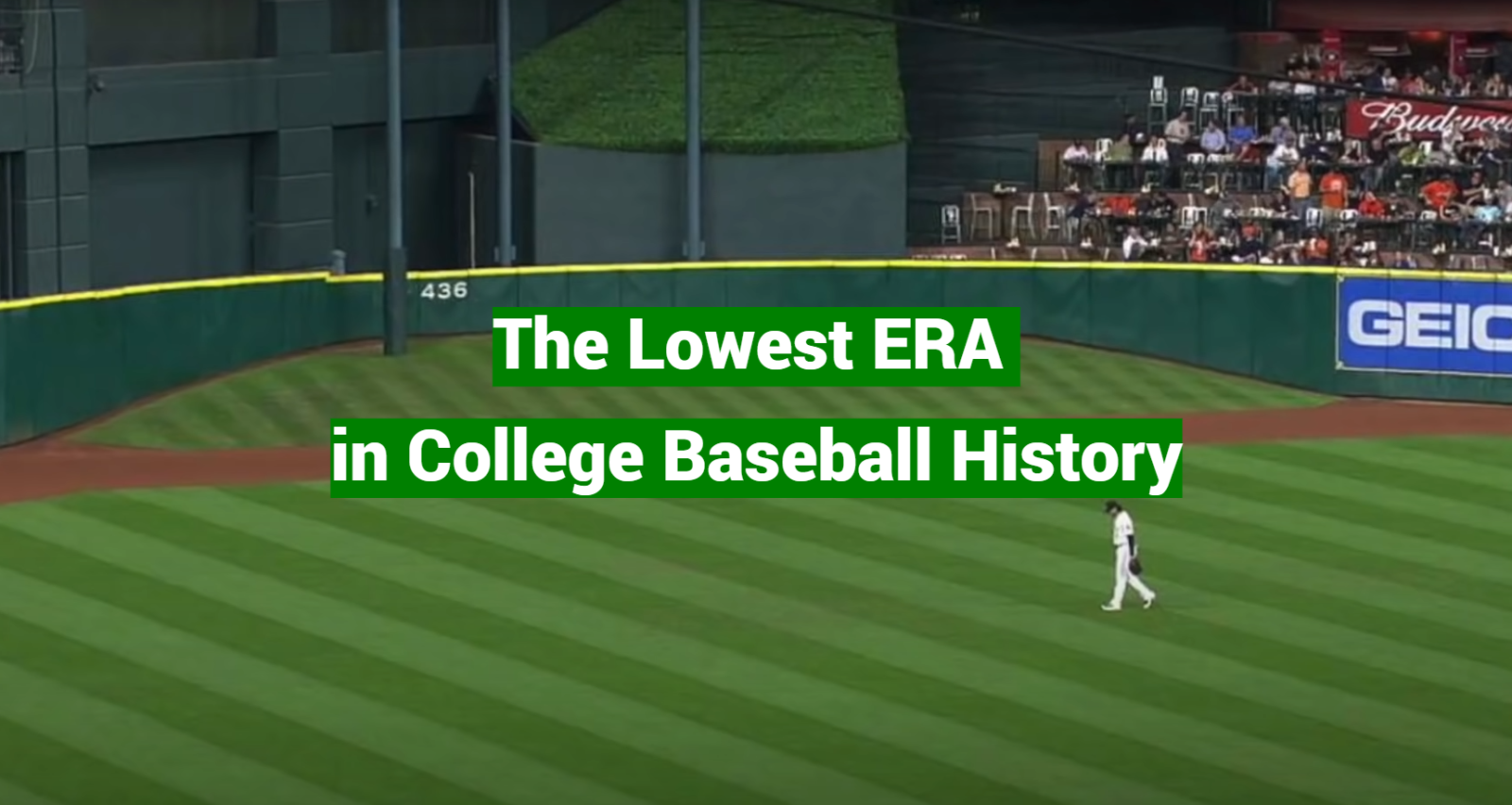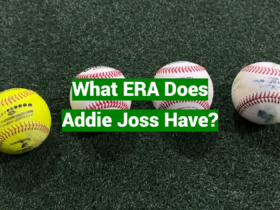Baseball, often hailed as America’s pastime, holds a special place in the realm of college sports, where young athletes showcase their skills on the diamond. In this competitive landscape, pitching is paramount, and having a low Earned Run Average (ERA) is a testament to a pitcher’s mastery and finesse. ERA signifies the average number of earned runs a pitcher allows per nine innings and serves as a crucial barometer of their effectiveness.
This article delves into the historic achievements of college pitchers with the lowest ERAs, exploring the confluence of talent, discipline, and strategy that culminates in record-setting performances on the collegiate mound. From the precision of each pitch to the consistency required throughout a season, these pitchers have etched their names into the annals of college baseball history.
Table of Contents
What Does ERA Stand For?

What Are Earned and Unearned Runs:
To fully appreciate the significance of ERA, it’s critical to understand the concepts of earned runs and unearned runs, as these are the foundation upon which ERA is built.
Earned Run
An earned run is any run that scores against a pitcher without the benefit of an error or a passed ball. Essentially, it is a run for which the pitcher is considered responsible. If a batter hits a home run, for example, the run is earned because the outcome was solely the result of the batter’s skill versus the pitcher’s ability to prevent hits. Similarly, if a series of batters string together hits and walks to produce a run, those are considered earned runs. The integrity of this statistic lies in its ability to measure only what the pitcher could reasonably control — his or her own skill against the batters faced.
Unearned Runs
Conversely, unearned runs are the runs that score as a result of errors or passed balls by the defense. These are not charged to the pitcher’s record since they result from mistakes made by other players on the field. For instance, if a fielder commits an error that would have otherwise ended an inning, and a run scores thereafter, that run is unearned. The rationale behind this distinction is that pitchers should not be penalized in their statistical records for the failings of their teammates.
When Did the ERA Come into Major League Baseball History?
The concept of ERA was introduced to Major League Baseball (MLB) by writer and statistician Henry Chadwick in the 19th century. ERA became an official MLB statistic in 1912, providing a new quantitative measure for pitcher performance. It was a breakthrough because it offered a way to compare pitchers beyond simple win-loss records, which were heavily dependent on the team’s offensive performance.
Chadwick’s contributions to baseball statistics were so significant that he has been referred to as the “Father of Baseball” and was posthumously inducted into the Baseball Hall of Fame.
How to Calculate ERA in a Nine Innings Pitched Game?
Calculating a pitcher’s ERA is relatively straightforward. The formula is as follows:
ERA = (Earned Runs / Innings Pitched) * 9
Here’s a step-by-step breakdown of how to calculate a pitcher’s ERA:
- Determine Earned Runs: Total all the runs that scored against the pitcher that did not result from errors or passed balls;
- Total Innings Pitched: Count all the outs the pitcher records while on the mound and convert this number into innings. Since there are three outs in a full inning, a pitcher who records 18 outs pitched six full innings;
- Divide Earned Runs by Innings Pitched: Take the total number of earned runs and divide it by the total innings pitched. This gives you the average earned runs per inning;
- Multiply by Nine: Since a standard game is nine innings, multiplying the average earned runs per inning by nine will normalize the statistic to a per-game basis;
For example, if a pitcher has allowed 20 earned runs over 60 innings pitched, the calculation would be:
ERA = (20 / 60) * 9 = 3.00
This indicates that the pitcher allows an average of three earned runs every nine innings pitched.

As with many statistics in baseball, ERA can be influenced by factors such as the ballpark dimensions, quality of defense, and even weather conditions. However, despite its limitations, ERA remains a cornerstone of pitcher evaluation and a key stat for comparisons among pitchers within a season, across seasons, and historically throughout the game [2].
What Is a Good ERA:
When it comes to judging the performance of baseball pitchers, the Earned Run Average (ERA) is a statistic that stands at the forefront. Defined by Major League Baseball as the “number of earned runs a pitcher allows per nine innings,” this figure provides insight into how effective a pitcher is at preventing runs. But what exactly constitutes a good ERA? This can be contingent on several factors including the era of play, league averages, and the role of the pitcher on the team.
What is a Good Starting Pitcher’s ERA?
For a starting pitcher, maintaining an ERA as low as possible is key. Traditionally, an ERA under 4.00 is considered good, suggesting that the pitcher is consistently effective at preventing scoring. An ERA between 3.00 and 4.00 is seen as above average, while anything below 3.00 is excellent, typically achieved by the best pitchers in the league [3].
These figures, however, can fluctuate based on the offensive environment of the league at any given time. For instance, during the dead-ball era, an ERA below 2.00 was outstanding, while in more offensively potent periods, ERAs tend to be higher across the board.
What is a Good ERA of a Relief Pitcher?
The assessment of relief pitchers can differ slightly from starters due to their varied usage patterns and the situational nature of their appearances. A good ERA for a relief pitcher, particularly closers, often falls below 3.00, reflecting their role in preserving leads and securing victories in tight games. Some elite relievers consistently post ERAs under 2.00, but given the shorter innings pitched compared to starters, their ERAs are subject to more volatility with just a few bad outings.

The Peculiarities of College Baseball History
College baseball has its own set of historical peculiarities that have influenced scoring and, subsequently, what constitutes a good ERA. Different rules, such as the use of aluminum bats until recent years, have led to unique changes in scoring patterns compared to professional baseball. Historically, these factors have resulted in generally higher offensive numbers in college games, thus affecting what is considered a good ERA at that level.
The History Of Scoring In U.S. College Baseball
Tracing the history of scoring in U.S. college baseball, we notice significant shifts that have impacted ERA standards over time. In periods where higher scoring was prevalent, ERAs would naturally be higher. Conversely, in eras of diminished scoring, like when new bat standards were introduced to reduce the “trampoline effect” and enhance player safety, pitching stats improved accordingly.
Understanding what a good ERA is necessitates a look at the context of the specific period. For example, in today’s Major League Baseball, an ERA between 4.00 and 5.00 is considered average (Baseball Bible), whereas during different historical periods or at different levels of play, such as in college baseball, these standards may change. It is also essential to take into account the ballpark factors, the defensive support a pitcher receives, and the offensive environment of the league when evaluating a pitcher’s ERA.
The Lowest ERA In College Baseball History in 2023:
Michael Stanford (UC Irvine):
Michael Stanford, a junior left-handed pitcher from UC Irvine, had a breakout season in 2023. Stanford dominated opposing batters with his impressive control and devastating fastball, resulting in an astonishing ERA of 1.42. His remarkable performance earned him recognition as one of the best pitchers in college baseball history.
Connelly Early (Virginia):
Connelly Early, a senior right-handed pitcher from Virginia, had an exceptional season in 2023. Early’s pinpoint accuracy and deceptive pitches left batters puzzled, leading to an ERA of 1.64. His consistency and ability to keep opposing hitters off balance made him a force to be reckoned with on the mound.
Jacob Cravey (Samford):
Jacob Cravey, a sophomore right-handed pitcher from Samford, made a name for himself in the 2023 season. Despite his youth, Cravey displayed a maturity beyond his years, recording an ERA of 1.72. His ability to mix pitches and keep hitters guessing contributed to his success, making him a rising star in college baseball.

Connor Linchey (Saint Mary’s CA):
Connor Linchey, a senior left-handed pitcher from Saint Mary’s CA, had a phenomenal season in 2023. Linchey’s exceptional command and ability to change speeds kept opposing batters off balance, resulting in an ERA of 1.85. His cool composure under pressure made him a reliable ace for his team and a standout pitcher in college baseball.
Nick Payero (Seton Hall):
Nick Payero, a junior right-handed pitcher from Seton Hall, showcased his dominance on the mound in the 2023 season. Payero’s high-velocity pitches and devastating breaking balls baffled hitters, leading to an ERA of 1.92. His ability to consistently deliver under pressure earned him a place among the elite pitchers in college baseball history.
Chasing Perfection: Unveiling the Lowest ERA in College Baseball History
The hallowed halls of college baseball reverberate with legend, from the thunderous crack of Mike Piazza’s bat to the unhittable dominance of Stephen Strasburg. Yet, amidst the home run heroes and strikeout artists, one statistic reigns supreme: the Earned Run Average (ERA). It’s the ultimate measure of a pitcher’s mastery, the line in the sand separating brilliance from mere competence. And within this realm of control and stinginess, one name stands out above all others: Wyman Carey.
Carey, a junior at Bradley University in 1957, etched his name into the record books with a season-long ERA that defied belief: a microscopic 0.37. In an era known for high-scoring affairs and offensive explosions, Carey stood like a granite wall, allowing a mere three earned runs in 73 innings pitched. To put this feat in perspective, the average Division I pitcher in 2023 sported an ERA north of 4.00 [4]. Carey’s accomplishment wasn’t simply dominant; it was otherworldly.
But who was this enigma who defied every offensive onslaught? What were the secrets behind his unparalleled control? Delving into Wyman Carey’s story is like unearthing a forgotten treasure, a glimpse into a bygone era of college baseball where defense reigned supreme and pitchers ruled the diamond.
Born in 1935, Carey grew up in Peoria, Illinois, a baseball hotbed nestled in the heart of the Midwest. He honed his skills on local sandlots, developing a pinpoint fastball and a devastating curveball that dipped, danced, and darted like a moth drawn to a flame. By the time he reached Bradley, his talent was undeniable, earning him a starting spot on the Braves’ pitching staff.
Head coach Everett Bradley, a former minor league pitcher himself, recognized Carey’s potential and nurtured his unique talents. He instilled in him a philosophy of pitching to contact, relying on pinpoint accuracy and deceptive movement to induce weak ground balls and pop-ups. This approach dovetailed perfectly with Carey’s strengths, transforming him into a master of efficiency, rarely needing more than a few pitches to get his outs.

The 1957 season unfolded like a dream for both Carey and the Bradley Braves. The unassuming right-hander dominated from the opening pitch, baffling hitters with his pinpoint control and baffling off-speed repertoire. He rarely walked a batter, his strike-to-ball ratio a testament to his surgical precision. Game after game, he carved through opposing lineups, leaving bewildered batters flailing at air and frustrated coaches searching for answers.
But Carey’s dominance wasn’t solely about individual brilliance. The Bradley Braves fielded a stellar defense, effortlessly gobbling up ground balls and turning double plays like clockwork. The airtight combination of Carey’s pinpoint pitching and the team’s defensive prowess created an impenetrable fortress, leaving opponents gasping for air.
News of Carey’s exploits spread like wildfire, captivating the college baseball world. Newspapers marveled at his microscopic ERA, calling him “a one-man pitching machine” and “the human metronome”. Scouts flocked to Peoria, their notebooks overflowing with observations and dreams of unearthing the next pitching phenom.
Despite the accolades, Carey remained grounded. He focused on the task at hand, leading the Braves to a 22-8 record and a conference championship. His impact went beyond mere statistics; his calm demeanor and quiet leadership instilled confidence in his teammates, forging a united front that steamrolled through the competition.
However, like a shooting star streaking across the night sky, Carey’s brilliance was fleeting. He suffered a shoulder injury in his senior year, derailing his professional aspirations and relegating his name to the realm of “what-ifs.” He would later coach high school baseball, quietly passing on his knowledge and love for the game to the next generation.
Though his professional career never materialized, Wyman Carey’s legacy endures. His 0.37 ERA remains the holy grail of college baseball pitching, a benchmark of excellence that few have even approached. His story is a testament to the power of precision, the beauty of efficiency, and the enduring love for the game that transcends individual glory.
While time may have blurred the memories of his dominance, the legend of Wyman Carey lives on. He serves as a beacon for aspiring pitchers, a reminder that perfection, though fleeting, is always within reach for those willing to chase it with dedication and unwavering passion. The next time you witness a dominant pitching performance, remember the name Wyman Carey – the quiet titan who carved his name into the record books with an ERA that may never be touched, a testament to the enduring magic of college baseball.

FAQ:
1. What do college baseball coaches look for in recruits?
College baseball coaches typically look for a combination of skills, athleticism, work ethic, and coachability in recruits. They assess a player’s ability to contribute to the team and fit into their program.
2. What do college baseball scouts look for in a pitcher?
Scouts focus on a pitcher’s velocity, control, repertoire of pitches, command, stamina, and ability to handle pressure situations. Consistency and the potential for development are also key factors.
3. What do college baseball scouts look for in a catcher?
Catchers are evaluated based on their defensive skills, including framing, blocking, and throwing accuracy. Offensive capabilities, leadership, and game management skills are also considered.
4. What do college baseball scouts look for in a first baseman?
First basemen are judged on their fielding skills, agility, and ability to make plays. Offensive production, including hitting and power, is also a crucial factor in the evaluation process.
5. What do college baseball scouts look for in a third baseman?
Third basemen are assessed for their defensive skills, arm strength, and ability to make accurate throws. Offensive capabilities, including hitting for power and average, are also important.
6. What do college baseball scouts look for in a middle infielder?
Middle infielders are evaluated based on their defensive skills, agility, quickness, and ability to turn double plays. Offensive skills, including hitting and base-running, are considered as well.
7. What do college baseball scouts look for in a center fielder?
Center fielders are judged on their range, speed, ability to track and catch balls, and arm strength. Offensive production, including hitting and base-running, is also taken into account.
8. What do college baseball scouts look for in a corner outfielder?
Corner outfielders are assessed for their defensive skills, arm strength, and ability to make plays near the foul lines. Offensive capabilities, including hitting for power, are important factors.
9. Who has the lowest ERA in college baseball?
The specific player with the lowest ERA in college baseball can vary by season. It’s advisable to check the latest statistics for the most current information.
10. What’s the best record in college baseball history?
The best record in college baseball history can vary, and it’s essential to refer to the latest statistics for the most up-to-date information.
11. What is the longest hit streak in college baseball history?
The longest hit streak in college baseball history may vary by division and year. Current statistics should be consulted for the latest information.
12. Who is the winningest coach in college baseball history?
The winningest coach in college baseball history may change over time. Consult the latest records to determine the current coaching leader.
13. Who has the most College World Series appearances?
College World Series appearances may vary by team and over time. Check the latest records for the team with the most appearances.
14. What is the best winning percentage in college baseball history?
The best winning percentage in college baseball history can vary, and it’s advisable to look at the most recent statistics for the current leader.
15. Is a low ERA in college baseball good?
Yes, a low ERA in college baseball is generally considered a positive indicator of a pitcher’s effectiveness. It reflects their ability to prevent opposing teams from scoring runs.
16. Is a 3.5 ERA good in college baseball?
A 3.5 ERA in college baseball is respectable, but the assessment may depend on various factors, including the level of competition and prevailing pitching standards. Context is crucial in evaluating performance.
17. Who has the most men’s college baseball championships?
The team with the most men’s college baseball championships may vary. Check the latest records for the team with the most titles.
Useful Video: The Worst Play in College Baseball History? (Auburn vs. LSU 5/23/19)
References:
- https://www.ncaa.com/stats/baseball/d1
- https://en.wikipedia.org/wiki/College_baseball
- https://www.baseballamerica.com/stories/the-history-of-scoring-in-college-baseball/
- https://www.baseball-reference.com/leaders/earned_run_avg_season.shtml






Leave a Reply